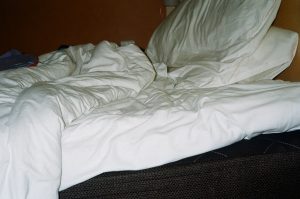To mark Spread the Word’s 30th Anniversary, three London-based deaf and disabled writers have been commissioned to create a short original piece of work. These Deaf and Disabled Writer Commissions showcase new work by three London-based deaf and disabled writers, and provide a developmental and profile-raising opportunity. Three London-based emerging writers have also been commissioned for our Emerging Writer Commissions.
The Deaf and Disabled Writer commissions, alongside Emerging Writer Commissions and Borough of Literature Commissions, were printed in the Deptford Literature Fesitval Anthology.
Flare: the muted outline of a body in bed as a camera flash overtakes the scene by Jamila Prowse
1. Bed, the dominating character of this series, fills the majority of the analogue photograph. White, generic sheets are those of a hotel room. The bedding is indented with lines, the duvet pulled back in disarray and the pillows are squashed. No body is present, but there is a ghostly allusion to the weight of a human form. Adding to the haunting effect, the light pools against the auburn wall, producing a slight halo above the bed. The misaligned mattress, with its visible seams, regrounds us in reality.
No one knows me better than my bed. Days, weeks, months and years, blur in the undefined passage of sick time. My imprint carved permanently into its contours. Sheets and pillows that understand me intimately. Bed: my constant companion. My closest confidante. To be sick is to succumb to it completely. The imminence of a crash forever looms on the periphery, threatening to overtake. My bed was an extension of my body — an extra limb — long before I spent a year fused to its surface. I never expected to become more disabled than I already was. For new barriers to sprout from the untended earth; unfamiliar, uninvited, unwelcome and yet here regardless. Insisting upon themselves.
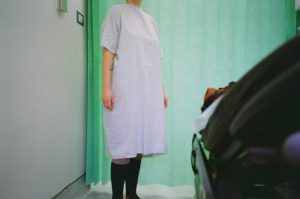
2. A body, beheaded by the camera, stands in a small, partitioned cubicle. All identifying characteristics have been scrubbed by the medical attire of a shapeless gown and knee high compression socks. Two uncovered arms hang limply from the billowing material. The wall on the left is bare, aside from a basic light switch, and the edge of an unidentified box. An out of focus mechanical bed protrudes from the right. A backdrop is provided by the luminescent green of a hospital curtain; the only vibrant colour.
New symptoms appear, seemingly from nowhere. Each one is a domino falling into the next. Living in bed causes chronic back pain. I take high dose painkillers and develop digestive issues. When I wean myself off the medication for my unruly mind, I hallucinate the sound of knocking. I wake fitfully throughout the night, convinced someone is on the other side of the door. I peer through the peephole in anticipation of a visitor. The empty hallway stares me down, predictable as ever. Pain is a dulled heart monitor, thrumming. Muscles I didn’t know could speak, fight to be heard above the constellation of complaining parts. My body doesn’t belong to me. Did it ever?
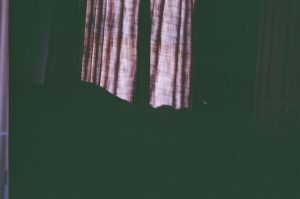
3. Darkness descends, confronting us with an assortment of indiscernible shapes. The closed curtains shut out the only source of light, dappling a lined motif across the fibres of the material. Just beneath the veiled window is a curving, bumpy outline. Peaks and troughs could communicate the uneven terrain of a hilly landscape, but here, they are the intimation of a dormant body. Imperfections of dust speckle the image. A light distortion leaks vertically across the left-hand edge. The precariousness of film photography is akin to disability.
A whole summer of bed. Never feeling the sun on my face, holding me with its gentle fingertips. I pull my curtains tight against the world. My own quiet protest. A refusal to let the outside infiltrate. It feels like mocking, the insistence to continue on without me. The sole marker of my formless days is the clockwork, ritualistic arrival of the ice cream van in the street outside. Seasonal sounds of freedom and play, drift in on the warm breeze.
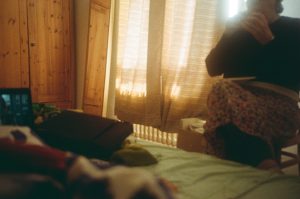
4. We find ourselves in another room. Or is it the same one? Hard to tell. The curtains remain purposefully sealed. Whereas before, the light couldn’t contend with the overwhelming darkness, here the sun is fierce, fighting through to illuminate the whole interior. Taken from bed, the edge of a mattress is busy with blankets and objects. A laptop screen is playing a film or TV series, though it’s unclear what. Reflected in a vertical mirror is a wooden wardrobe. A bleary bedside figure sits in a chair next to the bed, wearing a bold, floral skirt and black jumper. Held in both hands, they place a sandwich into their waiting mouth, and in the process hide their face.
To be cared for is to be witnessed in my most exposing, private moments. I dress in a uniform of the bedridden: old t-shirts worn with holes, pyjama trousers faded with overuse. My wardrobe is untouched. Moths feast in the crevices of stale fabrics. My mum didn’t anticipate the ways sickness would reshape our lives, colouring it in an unforgiving greyscale of repetition. Her adult daughter, thirty years old, reverted back to the helplessness of birth. We crowd each other. We breathe the same air until the room is tight and gasping for relief. Once connected to the mainland, our part of the world gradually breaks off until we are an island adrift, suddenly too far for anyone to brave the voyage and meet us where we’re at.
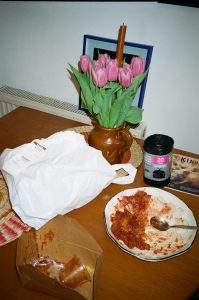
5. During school days, teachers would pose uninspiring fruit in ceramic bowls to paint from. If the arrangement on the screen is comparable, it is by accident. Rather, objects have been abandoned at random, as they often are in a preoccupied household. Atop a midcentury dining table is a muddle of kitchen paraphernalia. Some decorative: woven, circular mats, a ceramic jug filled with fresh pink tulips which obscures an artwork. A candlestick emerges from the flowers, part of the bouquet. Ruining the impression of order are objects of mess. A roll of bin bags. Old, half eaten food on plates and in boxes. A plastic bag with a receipt stapled to it. Viewing only a corner of the room, the clutter appears manageable. Easy to clean up. Who knows what level of disorder lurks beyond the frame.
A still life. Stilled life. The accumulated debris of a life unmanaged. Hinting at a wider scene. I exist, suspended, outside the realms of social acceptability. The washing-up piles high. Discarded food rots. Takeaway cartons stack haphazardly, a game of jenga. I await mum’s next day off work, to restore order to the chaos.
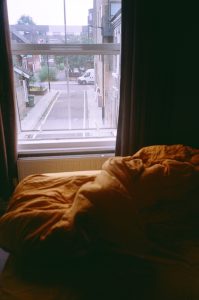
6. Jumble of sheets, we’ve come to know you well. This time, in a pleasing, ochre linen. No space next to the bed for a chair; this is not the same room from earlier. Unlike before, the curtains are open to an empty street; typically residential with houses, a green wheelie bin, and a parked van. Single yellow lines demarcate the road. The photograph looks out while separated from the external world.
A summer spent ferrying my ailing body between different beds, seeking refuge. Our little flat, gifted to us thirty years ago, when social housing still hung a safety net to catch our fall. It became inaccessible overnight. Planes trace chemtrails directly above, so when I stand up straight the crown of my head disturbs their foamy paths. Trains rattle our foundations. And all at once I cannot cope. I stop sleeping. I scream against the noise, adding to the atmosphere of unrest. A friend offers her home as sanctuary. I find somewhere else to lay my head, exchanging the steady caress of one mattress for another. If I listen closely enough, I can hear the reassuring pulse of a kindred crip body, beating softly through the wall.
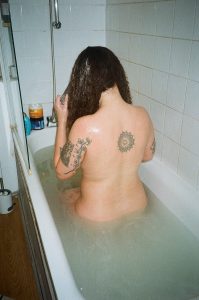
7. We’ve stumbled somewhere we shouldn’t be, as we observe a naked person from behind, sitting in clouded bathwater. Knotted curls are coated in a congealed conditioner. Pots of toiletries are on the side of the tub. Tattoos – black line drawings – are clearly visible on the skin. On the left, a tarot card, and the branch of a cherry blossom snake up the arm. A geometric flower is right in the middle of the back. The bathroom is that of a run down, rented home, with plain features and tiles. Folds of a soft body are reminiscent of the sheets in previous images.
My nakedness is base and functional, no longer a site of pleasure, wanting, desire. I go weeks without washing. The same pair of underwear grows stagnant between my legs. My hair is a tangled web of neglect. When mum finally lifts me into the depths of a bath, the murkiness tells stories of all the places my body hasn’t been, cannot go.

8. I want to show you my arm. But the camera has other ideas, bringing the background into focus and leaving me ill-defined. My palm is facing upwards. Long fingers. The red hospital bracelet on my wrist reduces me to a sequence of numbers and codes. The two tattoos on my forearm are fuzzy, as if I’ve forgotten to put my glasses on. You can just about make out a woman. Meanwhile, the rippled blanket holds a greater clarity. A celestial glow emits from the left corner, a result of light spilling under the emerald curtain.
Projected on a monitor, I watch as tubes journey through my insides. They are detectives searching for meaning of all the ways I’ve gone wrong. Dark caves inhabited by half-digested food. In the haze of sedation, I think of Lizzy turning her endoscopy into art. Fictionalising her own bodily expeditions. I speak, and my words echo in the sterile room: “this reminds me of Lizzy Rose.” The doctor looks at me, bemused, “I treated Lizzy.” For a moment, I am not alone. A fleeting thread links me to another crip body, traversing time and mortality, flattening the divide between life and death. Unified by shared experience. I post a letter to the other side, a prayer for her safe passage, to land somewhere gentler than here, weightless, floating in space, finally free of the physical barriers that bind us.
About Jamila Prowse
Jamila Prowse is an artist and writer, propelled by curiosity and a desire to understand herself. Informed by her lived experience of disability and mixed race ancestry, her work is research driven and indebted to Black feminist and crip scholars. She is an active participant in a rich and growing contemporary disabled artistic community and has been ongoingly researching, programming and creating around cripping the art world since 2018. Her writing has appeared in Frieze, Art Monthly and elsewhere.
